- All original finish on the guitar
- Flamed solid Maple back and sides
- Spruce top, with no finish on the spruce… this is a characteristic of guitars from this time and place. While the back and sides of the guitar were French polished, the spruce top was left as natural wood, with no finish.
- One of the friction pegs is a modern replacement
- The two dark splices on the soundboard are later, but still 19th century, restorations, done as decorative flourishes.
- Scale length: 64.3 cm
- Length of body: 43.3 cm
- Koliker, Luthier Rue Croix-des-Petits Champs No. 24 A. Paris
-
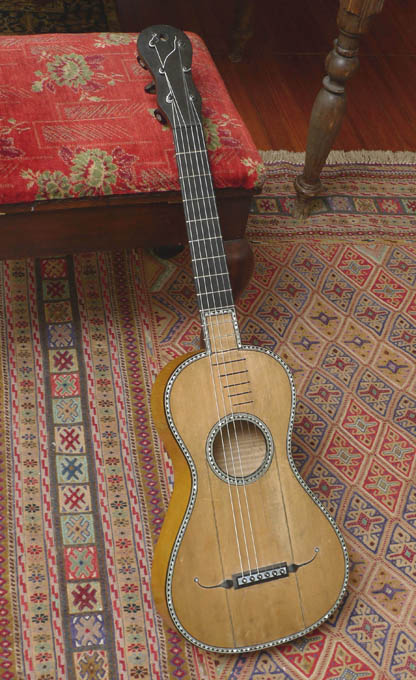 This fine and early example of the French guitar was made in Mirecourt, France, around 1800 to 1810. And sold through the famous Parisian dealer Koliker. It is a rare early example, as indicated by its rectangular bridge that does not have a separate saddle, but uses the top edge of the ebony rectangle as the saddle (this feature places it circa 1800, not like the more common 1820-1840 French guitars that have a more modern style bridge including a regular saddle). But for all its rarity, and exoticism to modern eyes, the most salient feature of this guitar is that it plays wonderfully. This is no museum piece to hang on a wall or shelf. This guitar is to play and enjoy. It plays beautifully, with all frets in tune. With no buzzing... I have had guitars from the 1960’s that do not play as well, in tune, and sound as well as this one. Even the action is perfect. The guitar has a wonderful tone, with a sweetness and brightness from the maple, and full bass response.
This fine and early example of the French guitar was made in Mirecourt, France, around 1800 to 1810. And sold through the famous Parisian dealer Koliker. It is a rare early example, as indicated by its rectangular bridge that does not have a separate saddle, but uses the top edge of the ebony rectangle as the saddle (this feature places it circa 1800, not like the more common 1820-1840 French guitars that have a more modern style bridge including a regular saddle). But for all its rarity, and exoticism to modern eyes, the most salient feature of this guitar is that it plays wonderfully. This is no museum piece to hang on a wall or shelf. This guitar is to play and enjoy. It plays beautifully, with all frets in tune. With no buzzing... I have had guitars from the 1960’s that do not play as well, in tune, and sound as well as this one. Even the action is perfect. The guitar has a wonderful tone, with a sweetness and brightness from the maple, and full bass response. -
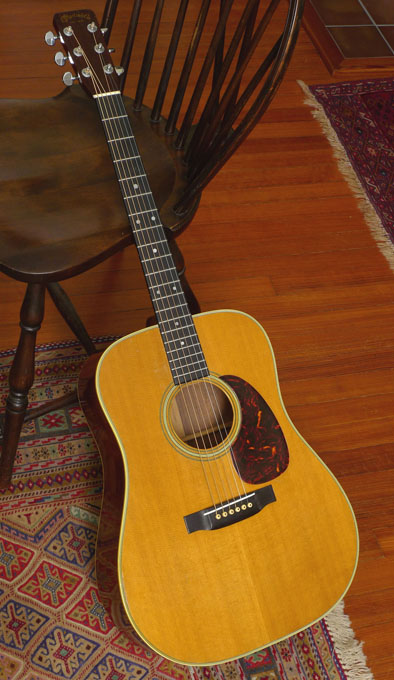 This Brazilian Rosewood D-28 dreadnaught from one of Martin’s finest eras, is special. Its structural integrity, and originality, are rare. And it’s one of the last Martin D-28’s made when Martin still used hide glue for guitar construction. This is a one-owner guitar, still in its original case. When we acquired it, it had not been played for years. Its original bridge, had a split in it, and had come loose from the top. Thus, it sat unplayed in its case for years. But all the wood beneath the bridge was pristine, perfect. So John Allison just made and installed a new exact reproduction bridge, from dark African ebony. It’s perfect, using the exact footprint of the original. The new bridge was attached with hide glue. And we used the original bridge pins.
This Brazilian Rosewood D-28 dreadnaught from one of Martin’s finest eras, is special. Its structural integrity, and originality, are rare. And it’s one of the last Martin D-28’s made when Martin still used hide glue for guitar construction. This is a one-owner guitar, still in its original case. When we acquired it, it had not been played for years. Its original bridge, had a split in it, and had come loose from the top. Thus, it sat unplayed in its case for years. But all the wood beneath the bridge was pristine, perfect. So John Allison just made and installed a new exact reproduction bridge, from dark African ebony. It’s perfect, using the exact footprint of the original. The new bridge was attached with hide glue. And we used the original bridge pins.- Guitar is 100% crack-free (no, not even a pickguard crack)
- 100% original finish, everywhere. No overspray or finish alterations of any kind. Minor dings and some minor pickwear around the soundhole.
- Has never had a strap lug attached
- Perfect condition maple bridge plate
- Original frets are in great condition
- Action is great, with just the right amount of saddle, and neck angle is perfect
-
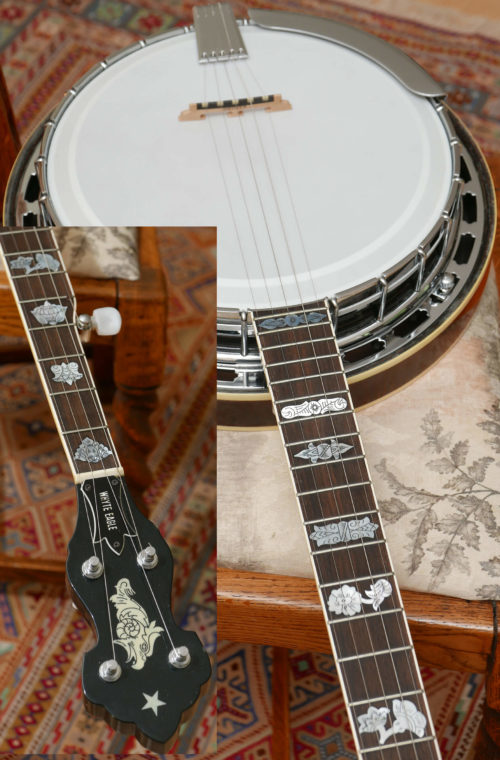 Early 1970s, but in remarkably original condition. And this instrument is from the first, early production– so it has the maple 3-ply rim. This should not be compared to later production Whyte Eagles– this is a very rare early one with unique features, and great tone. This banjo design is based on: • neck/head/inlays: based on the high end Fairbanks Whyte Ladye of the early 20th century– one of the most beautiful designs in banjo history • the pot assembly is modeled closely on the Gibson TB3, archtop of the 1930's. In fact it's a remarkable recreation of that design (and sound) – a more faithful recreation that many Gibson post-war versions. Bluegrass banjo players seek out the 70’s Alvarez Whyte Eagles, known for their tone and craftsmanship. It was a pretty short window of only about five years, when these banjos were made with this kind of craftsmanship. They blow away most any banjo made and marketed (from any country) in the 60s, 70s and 80s– and they show no logos on headstock– just beautiful mother of pearl. It’s the No. 4310 “Whyte Eagle”. Based on late 1920’s Vega Griffin (Tubaphone #9) style inlays, with engraved, carved heel. Sunburst finish maple banjo, Gibson-style 2 piece flange, full height 20 hole archtop tone ring, dual coordinator rods, flamed maple resonator, maple neck, chrome finish. Neck is butterfly with ebony strip on back of neck, down the center. It’s extremely rare to find a Whyte Eagle from this very early period (serial number 1672), when they first came out and the company bent over backwards to produce an instrument with zero compromise, from the inlays to the maple rim. The early features that are not on the later 70's Whyte Eagles, are– in addition to the 3-ply maple rim (not the 10-ply rim of almost all other Whyte Eagles)– the smaller star on the front of headstock (later models had a larger star), no “Alvarez” logo just the eagle inlay, and a darker sunburst on the resonator and also on the back of the neck. Flamed maple resonator (sunburst back, with a touch of milkiness to the original finish) Maple butterfly neck Hand-carved heel Mother of pearl inlays Original tuners Grover bridge 1 3/16 nut Scale: 26 ¼ inches 20 hole archtop tone ring 11 inch head ... no longer available ...
Early 1970s, but in remarkably original condition. And this instrument is from the first, early production– so it has the maple 3-ply rim. This should not be compared to later production Whyte Eagles– this is a very rare early one with unique features, and great tone. This banjo design is based on: • neck/head/inlays: based on the high end Fairbanks Whyte Ladye of the early 20th century– one of the most beautiful designs in banjo history • the pot assembly is modeled closely on the Gibson TB3, archtop of the 1930's. In fact it's a remarkable recreation of that design (and sound) – a more faithful recreation that many Gibson post-war versions. Bluegrass banjo players seek out the 70’s Alvarez Whyte Eagles, known for their tone and craftsmanship. It was a pretty short window of only about five years, when these banjos were made with this kind of craftsmanship. They blow away most any banjo made and marketed (from any country) in the 60s, 70s and 80s– and they show no logos on headstock– just beautiful mother of pearl. It’s the No. 4310 “Whyte Eagle”. Based on late 1920’s Vega Griffin (Tubaphone #9) style inlays, with engraved, carved heel. Sunburst finish maple banjo, Gibson-style 2 piece flange, full height 20 hole archtop tone ring, dual coordinator rods, flamed maple resonator, maple neck, chrome finish. Neck is butterfly with ebony strip on back of neck, down the center. It’s extremely rare to find a Whyte Eagle from this very early period (serial number 1672), when they first came out and the company bent over backwards to produce an instrument with zero compromise, from the inlays to the maple rim. The early features that are not on the later 70's Whyte Eagles, are– in addition to the 3-ply maple rim (not the 10-ply rim of almost all other Whyte Eagles)– the smaller star on the front of headstock (later models had a larger star), no “Alvarez” logo just the eagle inlay, and a darker sunburst on the resonator and also on the back of the neck. Flamed maple resonator (sunburst back, with a touch of milkiness to the original finish) Maple butterfly neck Hand-carved heel Mother of pearl inlays Original tuners Grover bridge 1 3/16 nut Scale: 26 ¼ inches 20 hole archtop tone ring 11 inch head ... no longer available ... -
Out of stock
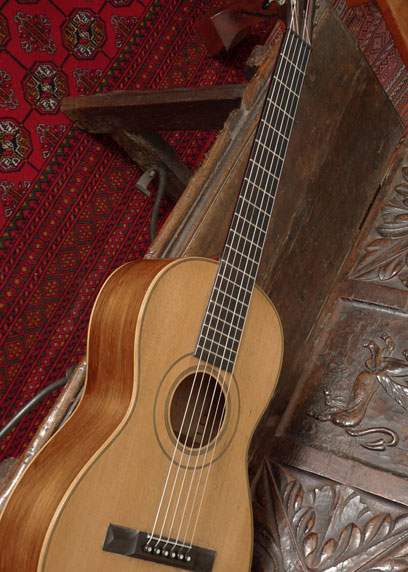 Circa 1860 guitar, style 3 built by well known luthier James Ashborn of Wolcottville, CT, for William Hall & Son music store. Brazilian rosewood back and sides; Adirondack top; maple binding. Rare Brazilian rosewood veneered neck. 100% original, including all original finish, and down to original nut, original bridge (and saddle) that has never been off the guitar. From an article in Vintage Guitar magazine: "Ashborn's design for the guitar was quite innovative for the early 19th century. Instead of making guitars fashioned after the typical parlor-style guitars, he made them in the Spanish style, by taking interior bracing cues from the Spanish while retaining the body of the English guitars. This included a fan brace pattern rather than the more common ladder pattern Ashborn guitars have a very complex dovetail V joint for attaching the head to the neck. The headstock was cut in roughly five steps, using some kind of tracing router, as suggested by the chatter marks on the inside ears of the pegbox. In addition to the complex head design, Ashborn made his own tuning machines in-house. They're made of brass, very much like contemporary machines, with worm gears, cog gears, and rollers. … Ashborn's shop was extremely advanced for its time, having a great deal of know-how and technology. Ashborn understood the need to have the technology as well as the skill, but more importantly he discovered a new way of making high-quality instruments that were affordable. He was able to create a factory environment where workers did what they were good at and, with practice, became very fast and consistent. With a new level of consistency in mass production, he created the path followed by other companies such as Martin, Gibson, and Taylor. Using designs ahead of his time, he was able to bring the sound and change to people who otherwise never would have been able to acquire an instrument of this quality."
Circa 1860 guitar, style 3 built by well known luthier James Ashborn of Wolcottville, CT, for William Hall & Son music store. Brazilian rosewood back and sides; Adirondack top; maple binding. Rare Brazilian rosewood veneered neck. 100% original, including all original finish, and down to original nut, original bridge (and saddle) that has never been off the guitar. From an article in Vintage Guitar magazine: "Ashborn's design for the guitar was quite innovative for the early 19th century. Instead of making guitars fashioned after the typical parlor-style guitars, he made them in the Spanish style, by taking interior bracing cues from the Spanish while retaining the body of the English guitars. This included a fan brace pattern rather than the more common ladder pattern Ashborn guitars have a very complex dovetail V joint for attaching the head to the neck. The headstock was cut in roughly five steps, using some kind of tracing router, as suggested by the chatter marks on the inside ears of the pegbox. In addition to the complex head design, Ashborn made his own tuning machines in-house. They're made of brass, very much like contemporary machines, with worm gears, cog gears, and rollers. … Ashborn's shop was extremely advanced for its time, having a great deal of know-how and technology. Ashborn understood the need to have the technology as well as the skill, but more importantly he discovered a new way of making high-quality instruments that were affordable. He was able to create a factory environment where workers did what they were good at and, with practice, became very fast and consistent. With a new level of consistency in mass production, he created the path followed by other companies such as Martin, Gibson, and Taylor. Using designs ahead of his time, he was able to bring the sound and change to people who otherwise never would have been able to acquire an instrument of this quality." -
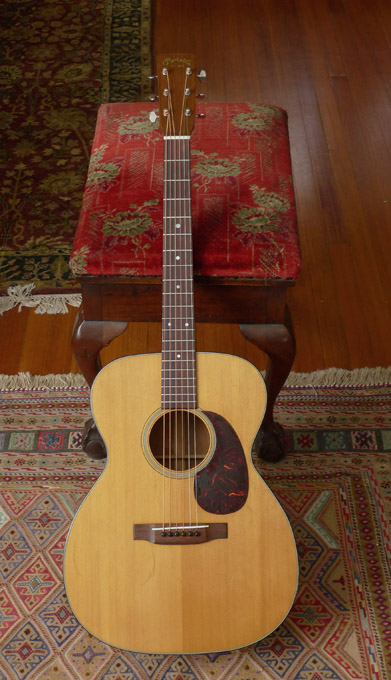 This ’63 000-18 has wonderful tone. It compares favorably to any post-war 000-18 we’ve played.
This ’63 000-18 has wonderful tone. It compares favorably to any post-war 000-18 we’ve played.- All original finish, everywhere
- The guitar is crack-free. Not even a pickguard crack.
- Original Brazilian Rosewood bridge, full height. It has never been off
- original saddle as well
- Original tuners (Grover)
- Original Ivory nut
- Original bridge plate… in perfect condition… in fact, there is not even the enlarged holes you so commonly see from the ball ends of strings working through… it’s a great original small Maple bridge plate…
- Original endpin
- There is some pick wear, and some typical crazing that 60’s Martins all have
- Frets are in good shape. The first several positions show some wear… but not a lot… it does not need new frets.
-
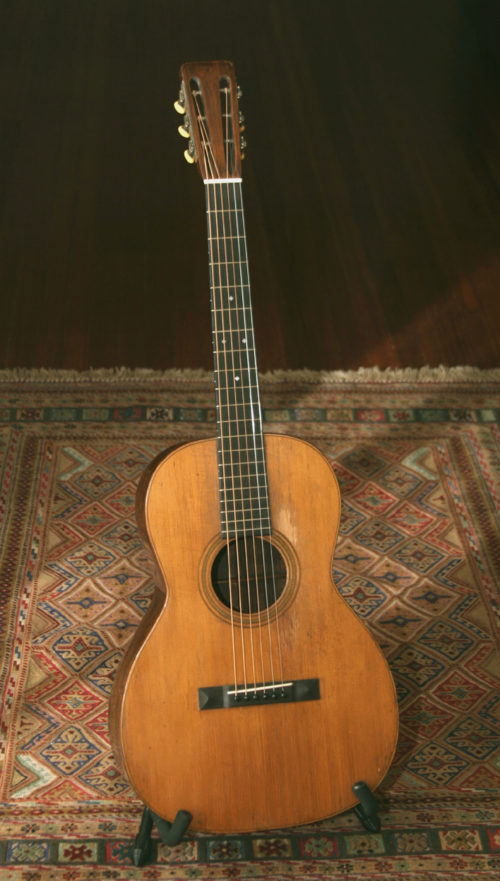 This big 12-fret Brazilian Rosewood pre-war Martin is properly set up for steel strings, with new replacement ebony pyramid bridge meticulously made to original specs, but compensated for steel string, perfect intonation. All braces original and in great shape. Original bridge plate. All original finish everywhere. This guitar has all the tone you'd expect from a pre-war 00 Brazilian Martin. It's had restoration work, all by us, recently, as follows. Hide glue used in all repairs/restoration.
This big 12-fret Brazilian Rosewood pre-war Martin is properly set up for steel strings, with new replacement ebony pyramid bridge meticulously made to original specs, but compensated for steel string, perfect intonation. All braces original and in great shape. Original bridge plate. All original finish everywhere. This guitar has all the tone you'd expect from a pre-war 00 Brazilian Martin. It's had restoration work, all by us, recently, as follows. Hide glue used in all repairs/restoration.- Several cracks in sides, back, and top professionally repaired (5 or 6 cracks overall)
- Small hole drilled in top of headstock many decades ago (to hang the guitar on a wall presumably) has been expertly filled and finished with a piece of Brazilian rosewood veneer, on front, to match the veneer of the headstock.
- Neck set.
- New replacement ebony pyramid bridge meticulously made to original specs, but compensated to steel string intonation. Scratch marks in spruce top, on either side of bridge, filled and finished.
- All new, replacement Bar Frets
- To the thin maple, original bridge plate, we carefully added tiny maple ring/plugs, with hide glue, into the holes, to address bridge pins holes slightly enlarged over the years.
- Older repaired small crack in heel expertly touched up. It's 100% stable. (It appears to be a surface/finish crack.) It's very hard to see even up close, and impossible to photograph.
-
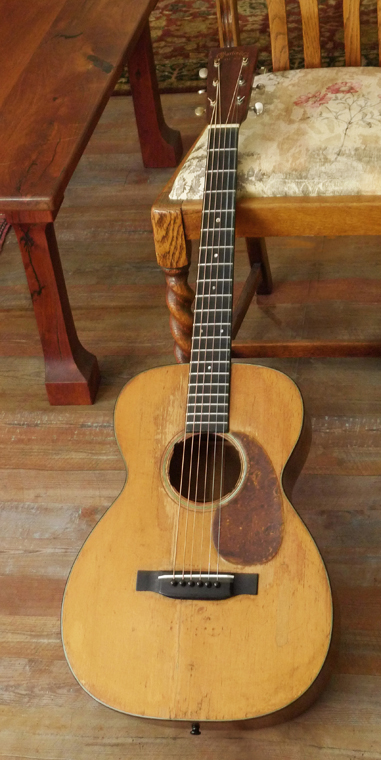 This guitar is probably among the first twenty Martins made in 1939 after the change in nut width on 14-fret models from 1 3/4" to 1 11/16", so yes it is 1 11/16. It has all original finish. Original tuners. Original maple bridge plate. It has multiple repaired cracks on top and sides (no cracks on back). Extensive play wear. New, but perfect, historically correct reproduction Ebony bridge.
This guitar is probably among the first twenty Martins made in 1939 after the change in nut width on 14-fret models from 1 3/4" to 1 11/16", so yes it is 1 11/16. It has all original finish. Original tuners. Original maple bridge plate. It has multiple repaired cracks on top and sides (no cracks on back). Extensive play wear. New, but perfect, historically correct reproduction Ebony bridge. -
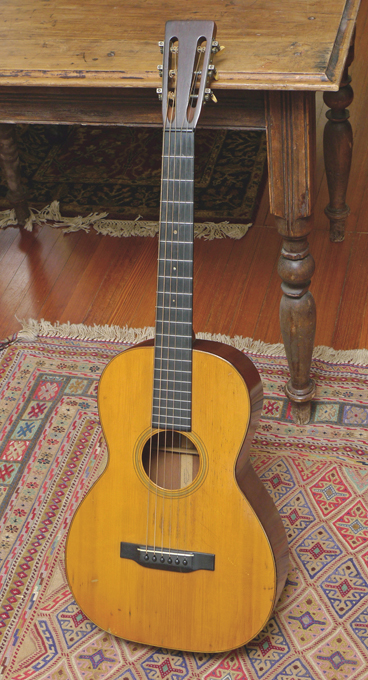 An all-original Martin from the finest era in the company’s history, this 0-18 is unsurpassed for Martin 12-fret Adirondack spruce over Mahogany tone. What can you add about a 1930 Martin, that is 100% original, down to the original bridge pins, and original ivory saddle This example is from the time when Martin had just started using belly bridges, and the ebony belly bridge on this guitar still has its original ivory saddle. And this guitar is 100% crack-free. Period. The instrument features the original bridge (full height), original tuners, original ivory saddle, original nut, and original maple bridge plate (the bridge plate shows almost no wear from ball ends–almost unheard of in a prewar Martin). All original finish– everywhere. Some honest playwear and various minor nicks and dings give the wonderfully aged and naturally honey-hued Adirondack top character. The top shows perfect form, with no bellying behind the bridge, etc. One of the things that makes Martin’s from these year so great-sounding: Martin was still using a thin ebony rod inside the neck, not a metal bar. So the instrument is more free to resonate, from tuners, right down to the bridge. And resonate this one does, with a strong bass especially that puts many many large size guitars to shame. 1-7/8 inch nut. The neck has just been set, by us, retaining the original Bar frets
An all-original Martin from the finest era in the company’s history, this 0-18 is unsurpassed for Martin 12-fret Adirondack spruce over Mahogany tone. What can you add about a 1930 Martin, that is 100% original, down to the original bridge pins, and original ivory saddle This example is from the time when Martin had just started using belly bridges, and the ebony belly bridge on this guitar still has its original ivory saddle. And this guitar is 100% crack-free. Period. The instrument features the original bridge (full height), original tuners, original ivory saddle, original nut, and original maple bridge plate (the bridge plate shows almost no wear from ball ends–almost unheard of in a prewar Martin). All original finish– everywhere. Some honest playwear and various minor nicks and dings give the wonderfully aged and naturally honey-hued Adirondack top character. The top shows perfect form, with no bellying behind the bridge, etc. One of the things that makes Martin’s from these year so great-sounding: Martin was still using a thin ebony rod inside the neck, not a metal bar. So the instrument is more free to resonate, from tuners, right down to the bridge. And resonate this one does, with a strong bass especially that puts many many large size guitars to shame. 1-7/8 inch nut. The neck has just been set, by us, retaining the original Bar frets -
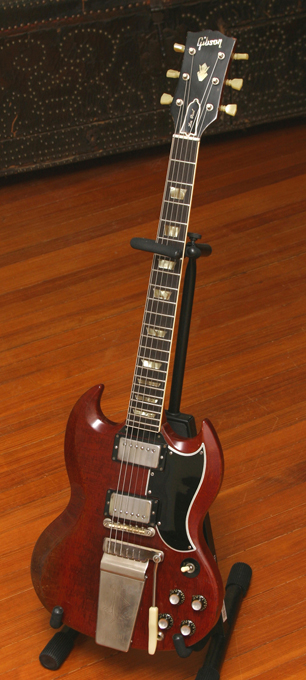 1963 and 1964 were the best years for the legendary early 60's Gibson SG. And 63-64 saw the transition from the Les Paul model to the "Solid Guitar" or SG. Only in 63 and 64 did Gibson use a particularly wide neck on the SG, and that's why players love SG's from these two seminal years. This '64 SG is something of a transition model from the last of the double cutaway Les Paul/SG's to the SG Standard-it carries the Les Paul truss rod cover (original to the guitar), and it features the great lyre vibrola (nickel). This 1964 SG, with all original finish, and original parts (including Patent # humbuckers), is a wonderful instrument with the right amount of honest wear to make it fit like a glove, and play like a dream in your left hand with that wonderful ample neck.
1963 and 1964 were the best years for the legendary early 60's Gibson SG. And 63-64 saw the transition from the Les Paul model to the "Solid Guitar" or SG. Only in 63 and 64 did Gibson use a particularly wide neck on the SG, and that's why players love SG's from these two seminal years. This '64 SG is something of a transition model from the last of the double cutaway Les Paul/SG's to the SG Standard-it carries the Les Paul truss rod cover (original to the guitar), and it features the great lyre vibrola (nickel). This 1964 SG, with all original finish, and original parts (including Patent # humbuckers), is a wonderful instrument with the right amount of honest wear to make it fit like a glove, and play like a dream in your left hand with that wonderful ample neck. -
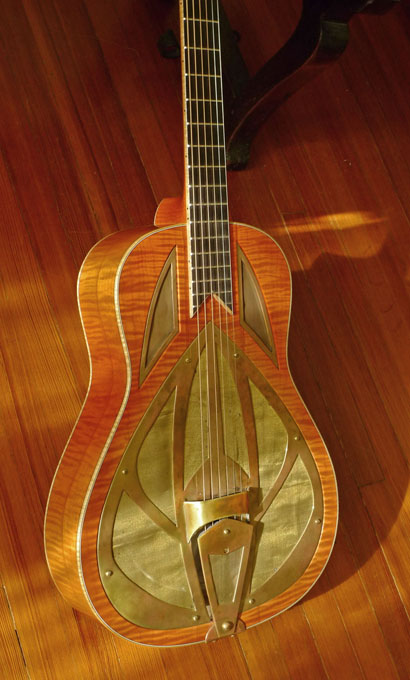 This stunningly beautiful, one-of-a-kind custom built resonator (from 2006, in beautiful crack-free condition and with only light wear) is from Tony Nobles, well-known luthier, and maker of instruments for Joe Walsh, Billy Gibbons and many other artists. The art deco ornamentation compliments an incredibly well built instrument, with meticulous attention to detail. Listen to/watch the video clip where guitar master Redd Volkaert put this instrument through some interesting jazz and blues paces.
This stunningly beautiful, one-of-a-kind custom built resonator (from 2006, in beautiful crack-free condition and with only light wear) is from Tony Nobles, well-known luthier, and maker of instruments for Joe Walsh, Billy Gibbons and many other artists. The art deco ornamentation compliments an incredibly well built instrument, with meticulous attention to detail. Listen to/watch the video clip where guitar master Redd Volkaert put this instrument through some interesting jazz and blues paces.- Spun-aluminum Quartermane biscuit-style cone (single-cone resonator)
- Solid curly maple, back top, and sides, with light tobaccoburst nitrocellulose lacquer finish
- Art deco coverplate, soundholes, and tailpiece of antiqued brass with a metal mesh covering
- Maple binding on body
- Custom torch inlay on headstock
- Curly maple neck
- Waverly tuners
- Scale: 24.4 inches
- Nut width: 1 7/8 inch
- String spacing at nut: 1 18/32
- Bridge spacing: 2 1/8
- Lower Bout: 14 1/2
- Upper bout: 9 1/2
- Body depth at bottom: 3 ¾ inches
- Body depth at neck joint: 3-20/32
-
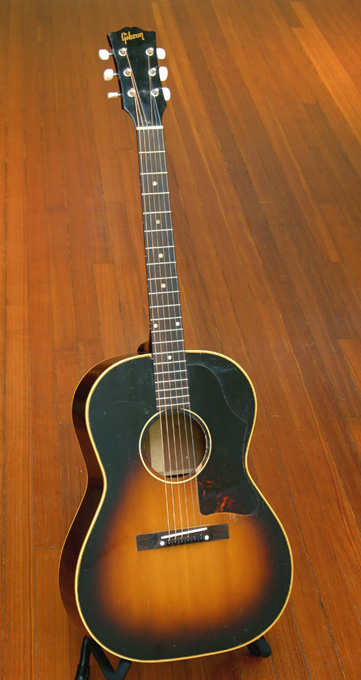 A wonderful, completely crack-free LG-2. The neck was recently set by Mark Erlewine, the frets dressed, and a new saddle installed ... beautifully set up by ME. 1-11/16 inch nut. Mahogany back and sides. Spruce top. Low action, with no buzzing. Nice sustain, and volume.
A wonderful, completely crack-free LG-2. The neck was recently set by Mark Erlewine, the frets dressed, and a new saddle installed ... beautifully set up by ME. 1-11/16 inch nut. Mahogany back and sides. Spruce top. Low action, with no buzzing. Nice sustain, and volume. -
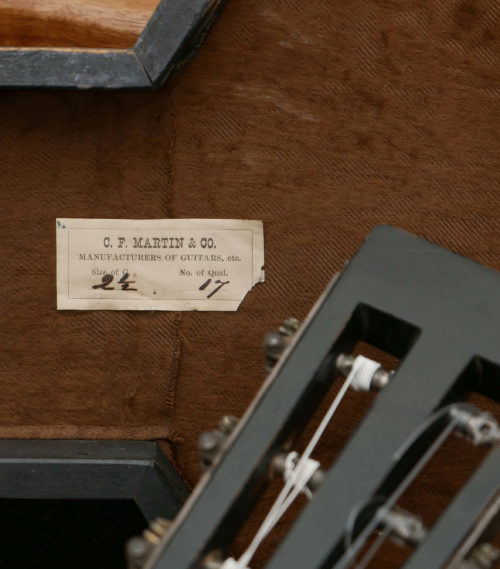 19th century Martin parlor guitar. This lovely sounding Martin 2 1/2-17 features solid Brazilian Rosewood back and sides, Adirondack spruce top, and original Jerome tuners. This particular instrument has a beautiful, lyrical voice. It was made probably circa 1867-1870. There are several clues to establish that: the original coffin case with the guitar has attributes of an earlier case: the small brass handle, and the label inside the case has font and other attributes of late a 1860s case. Also, the particular style of the original Jerome Tuners. Kerfing inside is also indicative of an 1860’s Martin. And, the best clue of all: the 1 ¾ inch nut width. Of course, it’s post-1867, because of the “CF Martin & Co” stamps inside. The top is fan braced, typical of this style. Measurements are: body length 17 7/8", lower bout width 11 5/8", overall length 36 1/2"; scale length 24 ½ inches. 4 inch body depth at end pin; 3 3/8 inch boy depth at neck joint. 1 ¾ inch nut width– may have been a custom order, or just a slightly narrower nut width (from the 1 7/8 more common later) from the factory. 12 fret cedar neck/ebonized, with ice cream cone heel. All original finish, everywhere. A fair-to-low amount of playwear (see photos). Original bar frets in fine condition. Several small hairline cracks in back, repaired. Top and sides also have a couple or repaired cracks. Reproduction ebony bridge– just made by Dick Dubois.. Original bar frets. Original bracing. "C.F. MARTIN &CO/ NEW YORK" hot stamped on back strip inside, and heel block. CF Martin New York stamped on back, by heel joint. Original Jerome tuners, with original buttons– note, one of the sun gears (on the G string tuner) has been replaced, with a different 19th century Martin sun gear (see photo). Historical interest aside (these just-post-civil war Martin guitars are more rare than the 1870’s/1880’s/1890’s examples), this guitar plays wonderfully. It projects glassy brazilian trebles, and clear mids and bass notes. It’s just a joy to play, and it just floats in your hands (due to its very light weight). Action is good, and it plays in tune even on the higher frets. (Note: 19th century Martins can be fitted with: gut strings, classical guitar strings, or sometimes silk and steel/tuned down–depending on the guitar. It’s really a case-by-case basis. One size does not fit all. And different 19th century Martins sound better with different strings. In this case, with this particular guitar, our favorite strings if you want a “classical” style string but more brightness and volume than nylon classical strings: Savarez Alliance composite High Tension strings (note, “high tension” by classical standards– fine for this instrument). This instruments sounds wonderful with those strings. In is original coffin case (and case has all the original hardware, as well as its original cloth interior lining).
19th century Martin parlor guitar. This lovely sounding Martin 2 1/2-17 features solid Brazilian Rosewood back and sides, Adirondack spruce top, and original Jerome tuners. This particular instrument has a beautiful, lyrical voice. It was made probably circa 1867-1870. There are several clues to establish that: the original coffin case with the guitar has attributes of an earlier case: the small brass handle, and the label inside the case has font and other attributes of late a 1860s case. Also, the particular style of the original Jerome Tuners. Kerfing inside is also indicative of an 1860’s Martin. And, the best clue of all: the 1 ¾ inch nut width. Of course, it’s post-1867, because of the “CF Martin & Co” stamps inside. The top is fan braced, typical of this style. Measurements are: body length 17 7/8", lower bout width 11 5/8", overall length 36 1/2"; scale length 24 ½ inches. 4 inch body depth at end pin; 3 3/8 inch boy depth at neck joint. 1 ¾ inch nut width– may have been a custom order, or just a slightly narrower nut width (from the 1 7/8 more common later) from the factory. 12 fret cedar neck/ebonized, with ice cream cone heel. All original finish, everywhere. A fair-to-low amount of playwear (see photos). Original bar frets in fine condition. Several small hairline cracks in back, repaired. Top and sides also have a couple or repaired cracks. Reproduction ebony bridge– just made by Dick Dubois.. Original bar frets. Original bracing. "C.F. MARTIN &CO/ NEW YORK" hot stamped on back strip inside, and heel block. CF Martin New York stamped on back, by heel joint. Original Jerome tuners, with original buttons– note, one of the sun gears (on the G string tuner) has been replaced, with a different 19th century Martin sun gear (see photo). Historical interest aside (these just-post-civil war Martin guitars are more rare than the 1870’s/1880’s/1890’s examples), this guitar plays wonderfully. It projects glassy brazilian trebles, and clear mids and bass notes. It’s just a joy to play, and it just floats in your hands (due to its very light weight). Action is good, and it plays in tune even on the higher frets. (Note: 19th century Martins can be fitted with: gut strings, classical guitar strings, or sometimes silk and steel/tuned down–depending on the guitar. It’s really a case-by-case basis. One size does not fit all. And different 19th century Martins sound better with different strings. In this case, with this particular guitar, our favorite strings if you want a “classical” style string but more brightness and volume than nylon classical strings: Savarez Alliance composite High Tension strings (note, “high tension” by classical standards– fine for this instrument). This instruments sounds wonderful with those strings. In is original coffin case (and case has all the original hardware, as well as its original cloth interior lining). -
Out of stock
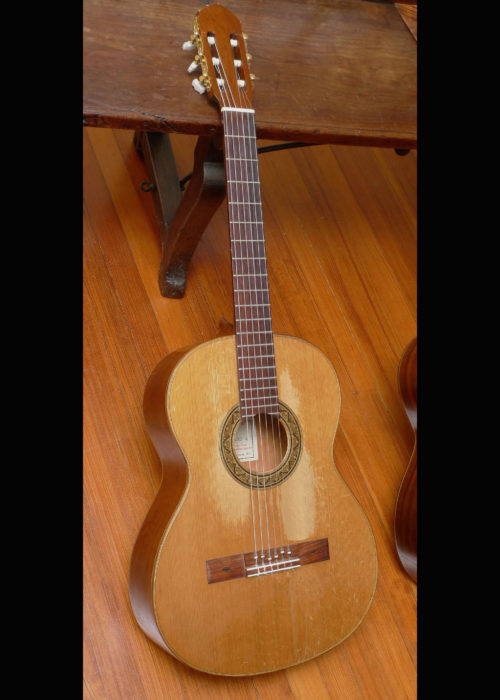
- Cedar top
- Depth at lower bout: 4 3/16 inches
- Width of neck at nut: 2 inches
- Body length: 19 3/4
-
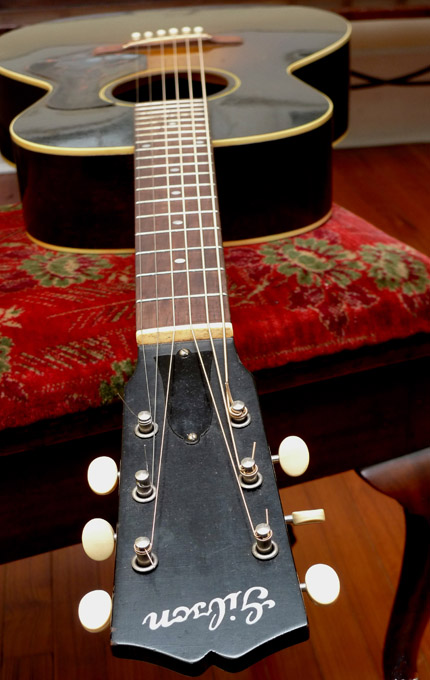 Crack-free, and 100% original, down to the bridge pins, and the original Geib case. Just getting a neck set to make it play perfectly.
Crack-free, and 100% original, down to the bridge pins, and the original Geib case. Just getting a neck set to make it play perfectly. -
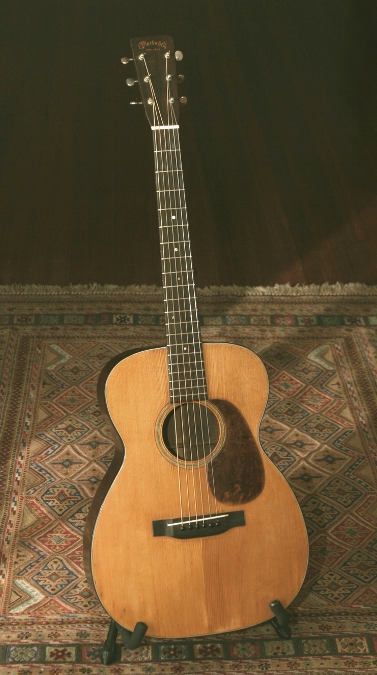 Probably the best year ever for 14-fret 00-18s. In the Golden Age of 14-fret Martins from the early 30's until the late 30's, only in 1936 did Martin use Brazilian rosewood (as opposed to ebony) for the fretboard and bridges of 18's, so its tone is considered by many to be the best in the 14 fret, 1-3/4 inch nut era. The guitar is crack-free on the top and back. Just one repaired crack on the treble side.The repair is well done and almost impossible to see from the outside (older repair has muslin cloth on inside-luthiers agree that these older cloth patches inside a vintage Martin should be left in place). Original tuners. Original bridge plate. Original nut. Replaced T-frets by us. Replacement bridge-very dark Brazilian rosewood bridge made to original specs in our shop, and ivory saddle. The neck has that wonderful mid-thirties slightly fatter profile. Neck set by us. And the tone is the best example of a Golden Era 00-18 you'll find anywhere. Light overspray (no refinishing) on back and sides (not top, neck or head).
Probably the best year ever for 14-fret 00-18s. In the Golden Age of 14-fret Martins from the early 30's until the late 30's, only in 1936 did Martin use Brazilian rosewood (as opposed to ebony) for the fretboard and bridges of 18's, so its tone is considered by many to be the best in the 14 fret, 1-3/4 inch nut era. The guitar is crack-free on the top and back. Just one repaired crack on the treble side.The repair is well done and almost impossible to see from the outside (older repair has muslin cloth on inside-luthiers agree that these older cloth patches inside a vintage Martin should be left in place). Original tuners. Original bridge plate. Original nut. Replaced T-frets by us. Replacement bridge-very dark Brazilian rosewood bridge made to original specs in our shop, and ivory saddle. The neck has that wonderful mid-thirties slightly fatter profile. Neck set by us. And the tone is the best example of a Golden Era 00-18 you'll find anywhere. Light overspray (no refinishing) on back and sides (not top, neck or head). -
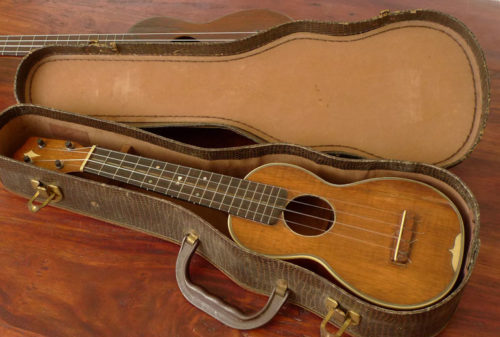 One of the first Martin 3K Ukeleles ever made. This is possibly a prototype, one of the first, all hand-made Martin 3K Ukeleles, made probably before the official introduction of the model by Martin in 1919-1920. It has many signs that it was the one of the first ones:
One of the first Martin 3K Ukeleles ever made. This is possibly a prototype, one of the first, all hand-made Martin 3K Ukeleles, made probably before the official introduction of the model by Martin in 1919-1920. It has many signs that it was the one of the first ones:- Ebony fretboard is hand-cut
- Fretboard inlays are hand-cut
- There is an "A" on the back of headstock... could be a marking by the Martin craftsmen in-house to indicate a prototype.
- Several cracks on back (repaired)
- Two cracks on top (repaired)
- There is one missing brace, a back brace, inside. Since ukeleles are so small, that brace has no real structural importance, so we decided not to replace it
- The sound hole was at some point enlarged slightly, either at the factory, or later. Probably later– so we’ll call it the Tony Rice model… this modification does add loudness
- The finish is all original.
- Original striped nut
- 3 lines inlaid down center of fingerboard.
- 7 ply side binding
- Celluloid ornament on top, behind bridge (known as the "parend").
- Small pearl paired-diamond inlays at fret 5, 7, 9– hand-cut. With the “bowtie” at the 7th fret
- Kite-shaped celluloid ornament on front of headstock
- Original friction pegs
- Ebony fretboard
- C.F. Martin & Co. stamp on back of headstock.
-
 A chance to own a great sounding, great playing Brazilian Rosewood D-28, at a fraction of the cost of an all-original example. This D-28 has had some work, and a few issues, but it’s all repaired and ready to play. And the tone is incredible– tone you won’t find in any other mid-50’s D-28. This guitar, has just been gone over head to end pin, repaired, restored, and set up, by two of the top luthiers/repairmen in Texas, and it’s good to go for decades. The bridge is perfect. Saddle is perfect height. Action is great– low but no buzzing. It won’t need a thing. Ready to play. The tone: the scalloped braces add roundness and clarity to the basses (A and D string in particular) and a bit more “ring” to the trebles. Don’t try this at home– a scalloped braced mid 50’s D-28, but the result, set up by two of this country’s top luthiers, is a great sounding brazilian Martin dread, whose tone you won’t find in any Martin north of 1944– certainly not at this price. Here’s the report:
A chance to own a great sounding, great playing Brazilian Rosewood D-28, at a fraction of the cost of an all-original example. This D-28 has had some work, and a few issues, but it’s all repaired and ready to play. And the tone is incredible– tone you won’t find in any other mid-50’s D-28. This guitar, has just been gone over head to end pin, repaired, restored, and set up, by two of the top luthiers/repairmen in Texas, and it’s good to go for decades. The bridge is perfect. Saddle is perfect height. Action is great– low but no buzzing. It won’t need a thing. Ready to play. The tone: the scalloped braces add roundness and clarity to the basses (A and D string in particular) and a bit more “ring” to the trebles. Don’t try this at home– a scalloped braced mid 50’s D-28, but the result, set up by two of this country’s top luthiers, is a great sounding brazilian Martin dread, whose tone you won’t find in any Martin north of 1944– certainly not at this price. Here’s the report:- sometime decades ago, the top braces were scalloped
- probably as a result of a minor impact at the end pin (guitar dropped), there were cracks in the sides, and a slight crack to the neck block. So a previous luthier, long before we acquired the guitar, put in 4 small wood dowels, through the sides–near the heel, into the block (see photos). All is stable. Not the prettiest solution, but it works well.
- Small crack in heel, repaired and stable
- Original finish, on Sitka Spruce top; Oversprayed back, sides, and neck (but back of neck finish has worn, giving a natural, comfortable feel)
- A bit of damage to one corner of the headstock. But there are no cracks in headstock.
- Pickup jack installed years ago at end pin; no pickup inside; Also, an old pickup jack on bass side of guitar, filled.
- Some pickwear loss, bottom edge of soundhole
- Top of guitar has no serious cracks. No "B string" pickguard crack. Tiny crack along the treble edge of the pick guard. A couple more finish type of cracks that do not go through the wood to inside.
- Several side cracks, all addressed.
- Back of guitar has no cracks through the wood. A couple of finish cracks.
- neck set, by John Allison
- Refret, by John Allison
- New, 100% period correct, ebony bridge, made and installed by John Allison. Bridge is made to the exact specs, footprint, etc, of an original 1956 Martin bridge. A small area of finish around an older oversized bridge was addressed by John (you can see this in the photos).
- New, period correct Maple bridge plate, installed by Tony Nobles
- Old pickup jack on bass side of guitar, filled by Tony Nobles.
- The wonderful, original gold-plated Kluson waffle-back tuners, are original, and work perfectly.
- Original pickguard
- Original Martin logo on headstock
-
 Another Gibson L-00, with great tone and volume, and all original finish. The top and sides are completely crack-free, and there are several small dryness cracks on the back. The bridge is original, and has never been off the guitar. We just set the neck, and installed a new bone saddle. The bridge plate is original and in perfect condition. Original firestripe pickguard. Original nut. Original frets.
Another Gibson L-00, with great tone and volume, and all original finish. The top and sides are completely crack-free, and there are several small dryness cracks on the back. The bridge is original, and has never been off the guitar. We just set the neck, and installed a new bone saddle. The bridge plate is original and in perfect condition. Original firestripe pickguard. Original nut. Original frets. -
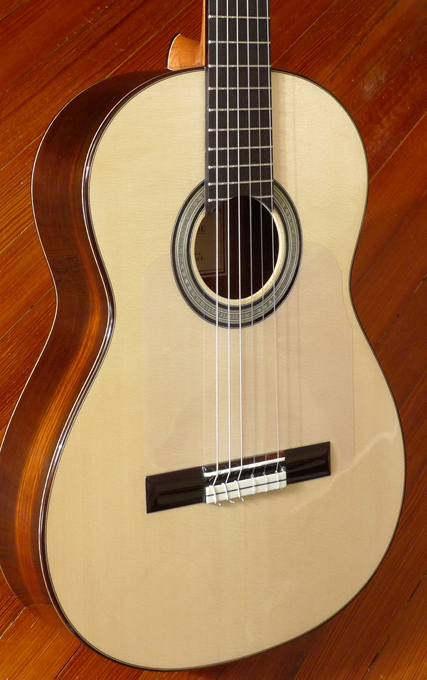 This new, custom made Lester Devoe Flamenco Negra is amasterpiece, from one of the world’s top luthiers. Lester Devoe needs nointroduction to the world’s great Flamenco players. The late, legendary Sabicasplayed a Devoe– and converted some of the great Flamenco players in Spain tothe fold. Paco De Lucia, and Vicente Amigo, among others, play Devoe Flamencoguitars. Paco De Lucia began playing a Devoe Negra guitar years ago– and thereare many Paco De Lucia recordings and feature films where Paco plays a DevoeFlamenco guitar.) This is the second custom guitar, that Lester has made for uswith select, old growth, quartersawn AAAAA Brazilian rosewood. Signed by LesterDevoe, 2012 (March).
This new, custom made Lester Devoe Flamenco Negra is amasterpiece, from one of the world’s top luthiers. Lester Devoe needs nointroduction to the world’s great Flamenco players. The late, legendary Sabicasplayed a Devoe– and converted some of the great Flamenco players in Spain tothe fold. Paco De Lucia, and Vicente Amigo, among others, play Devoe Flamencoguitars. Paco De Lucia began playing a Devoe Negra guitar years ago– and thereare many Paco De Lucia recordings and feature films where Paco plays a DevoeFlamenco guitar.) This is the second custom guitar, that Lester has made for uswith select, old growth, quartersawn AAAAA Brazilian rosewood. Signed by LesterDevoe, 2012 (March).- 650mm scale length
- Nut: 52mm
- Neck width at nut: 52mm
- 80 year old Brazilian Rosewood (pre-CITES) back and sides (Quartersawn).
- European spruce top
- Cedar neck
- Brazilian Rosewood headstock overlay, and bridge
- Brazilian Rosewood body binding, top and back
- Ebony fingerboard
- Sloane tuners
- Nitrocellulose lacquer finish
-
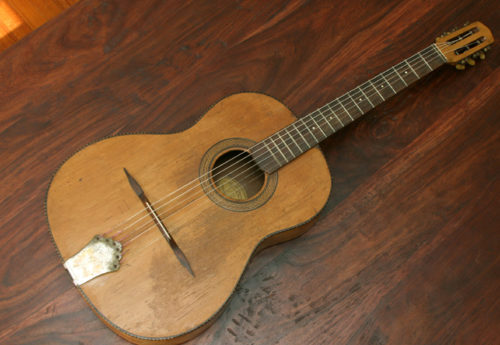 When Martin entered into its “Golden Age” for the flat top guitar, the jazz guitar was evolving on a parallel and equally important track. And in Europe, especially France, they had their own ideas about guitar making, and produced some brilliant guitars in this era–including of course the wonderful Selmer gypsy jazz guitar. The brothers Gerome were among the best luthiers in Mirecourt, France, a city famous in Europe for producing the finest gypsy and jazz guitars, in the 20s, 30s, and 40s. This all original, gypsy style guitar has maple back and sides, to give that high, twangy tone, just what you want in a django-style guitar. This one has loud piercing trebles–the treble strings are louder and more piercing than any guitar of any kind I have ever heard. Only maple produces that loud sharp treble. The volume of this instrument is striking, and there is almost a “reverb”, resonant quality to the tone. Solid spruce top. Black & white checkerboard marquetry binding on top, and rosette. It has a very thick rosewood fingerboard (over 4/10 inches/10.5mm thick!) Maple neck. Nut just shy of 1 7/8 inch. Wonderful bakelite buttons on the tuners. And it would not be a genuine gypsy jazz classic, if it did not have the hallmarks of this style: the original “floating bridge”–not an “adjustable brigde” for height, but a floating rosewood bridge that is not glued to the top, but held on by string tension (the “wings” of the bridge are glued to the top in this configuration). (You can of course change the intonation with this set-up.) The other feature that is a must, is the “zero fret”, i.e. there is a fret (the “zero” fret) right in front of the nut. 14-5/8 inch wide at lower bout. All original finish. A couple of small cracks on top. Top center seam repair. Original T-frets show wear, but still work fine. No buzzing. Action is good. Takes loop-end strings (available from many sources–Savarez Argentine strings are great on this instrument).
When Martin entered into its “Golden Age” for the flat top guitar, the jazz guitar was evolving on a parallel and equally important track. And in Europe, especially France, they had their own ideas about guitar making, and produced some brilliant guitars in this era–including of course the wonderful Selmer gypsy jazz guitar. The brothers Gerome were among the best luthiers in Mirecourt, France, a city famous in Europe for producing the finest gypsy and jazz guitars, in the 20s, 30s, and 40s. This all original, gypsy style guitar has maple back and sides, to give that high, twangy tone, just what you want in a django-style guitar. This one has loud piercing trebles–the treble strings are louder and more piercing than any guitar of any kind I have ever heard. Only maple produces that loud sharp treble. The volume of this instrument is striking, and there is almost a “reverb”, resonant quality to the tone. Solid spruce top. Black & white checkerboard marquetry binding on top, and rosette. It has a very thick rosewood fingerboard (over 4/10 inches/10.5mm thick!) Maple neck. Nut just shy of 1 7/8 inch. Wonderful bakelite buttons on the tuners. And it would not be a genuine gypsy jazz classic, if it did not have the hallmarks of this style: the original “floating bridge”–not an “adjustable brigde” for height, but a floating rosewood bridge that is not glued to the top, but held on by string tension (the “wings” of the bridge are glued to the top in this configuration). (You can of course change the intonation with this set-up.) The other feature that is a must, is the “zero fret”, i.e. there is a fret (the “zero” fret) right in front of the nut. 14-5/8 inch wide at lower bout. All original finish. A couple of small cracks on top. Top center seam repair. Original T-frets show wear, but still work fine. No buzzing. Action is good. Takes loop-end strings (available from many sources–Savarez Argentine strings are great on this instrument). -
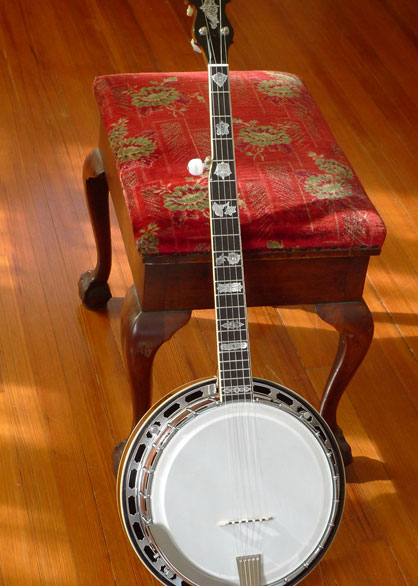 Late 1970s, but in almost unplayed condition. Bluegrass banjo players seek out these 70’s Whyte Eagles, known for their tone and craftsmanship. It was a pretty short window of only about five years, when these banjos were made with this kind of craftsmanship. They blow away most any banjo made and marketed (from any country) in the 60s, 70s and 80s– and they show no logos on headstock– just beautiful mother of pearl. It’s the No. 4310 “Whyte Eagle”. Based on late 1920’s Vega Griffin (Tubaphone #9) style inlays, with engraved, carved heel. Sunburst finish maple banjo, Gibson-style 2 piece flange, full height 20 hole archtop tone ring, dual coordinator rods, flamed maple resonator, maple neck, chrome finish. Neck is butterfly with ebony strip on back of neck, down the center. Just set up, with new tailpiece, and new head, by Dave Trexle and ready to play: loud, clear, and bright. With original hard shell case.
Late 1970s, but in almost unplayed condition. Bluegrass banjo players seek out these 70’s Whyte Eagles, known for their tone and craftsmanship. It was a pretty short window of only about five years, when these banjos were made with this kind of craftsmanship. They blow away most any banjo made and marketed (from any country) in the 60s, 70s and 80s– and they show no logos on headstock– just beautiful mother of pearl. It’s the No. 4310 “Whyte Eagle”. Based on late 1920’s Vega Griffin (Tubaphone #9) style inlays, with engraved, carved heel. Sunburst finish maple banjo, Gibson-style 2 piece flange, full height 20 hole archtop tone ring, dual coordinator rods, flamed maple resonator, maple neck, chrome finish. Neck is butterfly with ebony strip on back of neck, down the center. Just set up, with new tailpiece, and new head, by Dave Trexle and ready to play: loud, clear, and bright. With original hard shell case. -
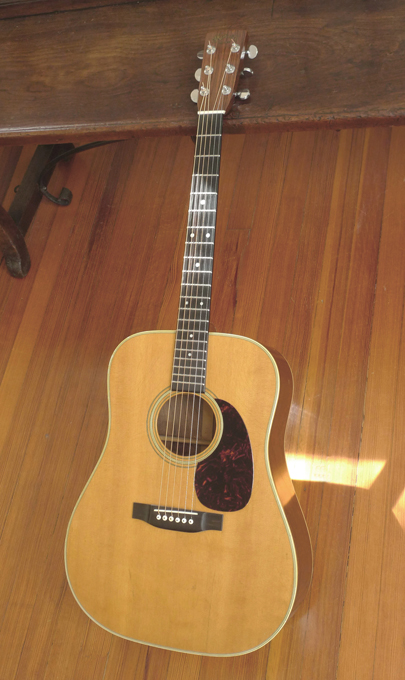 Very Nice Brazilian Rosewood D-28 dreadnaught.
Very Nice Brazilian Rosewood D-28 dreadnaught.- All original finish, bridge, bridge plate, tuners
- Newer saddle and nut, just installed to give perfect action, tone
- Original Tortoise pickguard
- Original small maple bridge plate, great condition
- Typical small “pickguard crack” as almost vintage Martins with pickguards have. It was professionally closed/glued years ago, stable and no longer an issue. There is a 4 2/3 inch finish crack, with 2 inches or so of that just barely visible from inside– located from edge of lower bout up, about 3 inches to the treble side of the center seam… professionally closed/glued years ago, stable and not an issue now
- Brazilian Rosewood back and sides: crack-free
- 100% original finish, everywhere. No overspray or finish alterations of any kind. Minor dings and some minor pickwear around the soundhole.
- Has never had a strap lug attached to the wood of the heel itself. There is a strap lug attached to the ivoroid heel cap.
- Original frets are in great condition… just a bit of wear, on frets 1-3/B string only
- Action is great– low and fast and loud, and neck angle is fine. Plenty of saddle left.
- Typical crazing of finish on top and back as seen on almost all mid-60s Martins (finish is all original, everywhere)
-
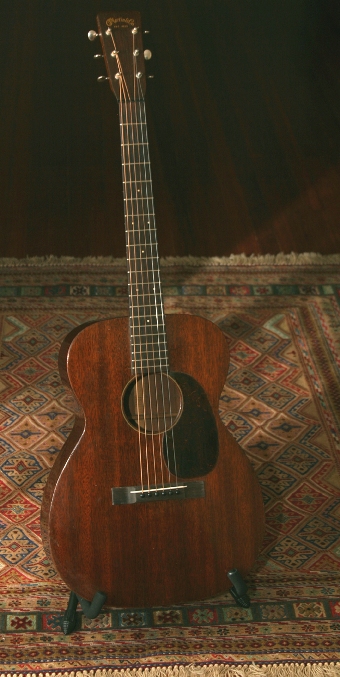 This model is something of a sleeper on the Golden Era Martin guitar market, because there are just not that many pre-1939 00-17s available. There are quite a few war-time and post-war 00-17s, but a 00-17 with full pre-war specs, forward shifted X-bracing, and 1 3/4 inch nut, is hard to come by–and they have all the great qualities of 00-sized Golden Era Martins that cost twice or three times the price on the vintage market–for now, as these great pre-war 00-17s will catch up quickly. The tone and volume of this 00-17 is astounding: full, amazingly bright, and with impressive volume. 1-3/4 inch nut width. Crack-free except for a well-repaired crack on bass side, about 2 inches long, that's difficult to see even up close. No cracks at all on top, or back. All original finish. Original bridge plate. This model has of course a mahogany top as well as mahogany back and sides. And with that dark look and original gloss finish that really sets this Golden Age Martin apart in its own class. Neck has the typically slightly beefier profile that's the hallmark of the best 30's 14-fret Martins. Neck was set by us. Replaced, period-correct Brazilian rosewood bridge. Original ebony nut. All new T-frets installed by us. Original tuners.
This model is something of a sleeper on the Golden Era Martin guitar market, because there are just not that many pre-1939 00-17s available. There are quite a few war-time and post-war 00-17s, but a 00-17 with full pre-war specs, forward shifted X-bracing, and 1 3/4 inch nut, is hard to come by–and they have all the great qualities of 00-sized Golden Era Martins that cost twice or three times the price on the vintage market–for now, as these great pre-war 00-17s will catch up quickly. The tone and volume of this 00-17 is astounding: full, amazingly bright, and with impressive volume. 1-3/4 inch nut width. Crack-free except for a well-repaired crack on bass side, about 2 inches long, that's difficult to see even up close. No cracks at all on top, or back. All original finish. Original bridge plate. This model has of course a mahogany top as well as mahogany back and sides. And with that dark look and original gloss finish that really sets this Golden Age Martin apart in its own class. Neck has the typically slightly beefier profile that's the hallmark of the best 30's 14-fret Martins. Neck was set by us. Replaced, period-correct Brazilian rosewood bridge. Original ebony nut. All new T-frets installed by us. Original tuners. -
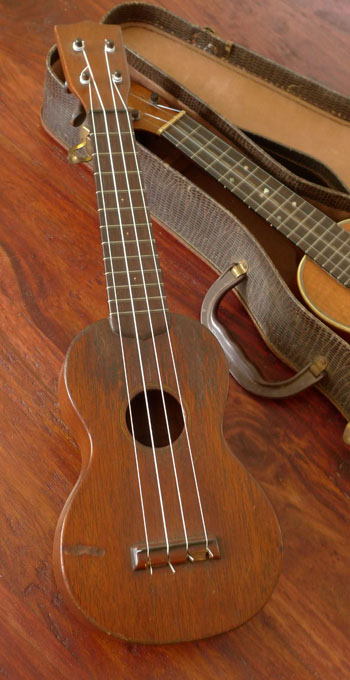 A pre-decal Uke from Martin. Style 0, with no body binding. Well worn, but 100% crack free.
A pre-decal Uke from Martin. Style 0, with no body binding. Well worn, but 100% crack free.